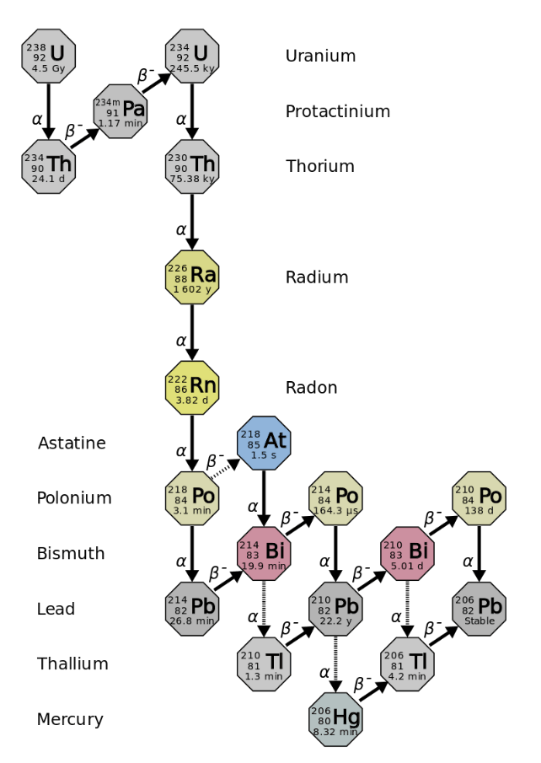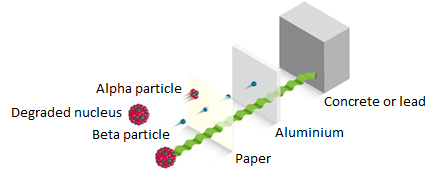Radioactivity is a natural phenomenon that has existed since the origins of the Earth. It is present everywhere: in the water, the air, the soil and the biota. The human being itself is radioactive.
There are two types of radioactivity: natural radioactivity and artificial radioactivity, also known as induced or man-made radioactivity respectively.
Natural radioactivity originates from various sources, such as:
- radioactive elements contained in the soil,
- cosmic radiation that comes from space and the Sun in particular, and
- radioactive elements that we absorb by breathing and nourishing ourselves.
Radioactivity can vary greatly depending on the nature of the local soil and altitude. For example, it is 5 to 20 times higher in granitic massifs than on sedimentary terrain due to the presence of uranium-bearing minerals, which decay. In regions of Brazil or southern India (Kerala), large populations inhabit areas where the natural radioactivity of the soil is 30 to 40 times greater than in Europe, due to the presence of thorium.
When considering altitude, the natural radioactivity due to cosmic radiation is 1.5 times higher at 1,500 metres above sea level.

Figure 1: Radioactive decay chain which produces Radon
Radioactive decay (also known as nuclear decay, radioactivity or nuclear radiation)
Is the process by which an unstable atomic nucleus loses energy by emitting radiation, such as an alpha, beta or gamma ray. A material containing such unstable nuclei is considered radioactive.
Radon is a radioactive, colourless, odourless and tasteless noble gas that escapes from rocks such as granite, having decayed from uranium-bearing minerals. It is one of the main sources of natural radioactivity[IE1] .
Artificial radioactivity
Artificial radioactivity is generated by a number of sources, predominantly medical applications and industrial activities such as coal combustion or the use of phosphate fertilizers (Figure 1). Nuclear power generation only makes up a small (0.01%) contribution to all artificial radioactivity.
In Europe, the average dose of a citizen that is being received during one year is about 5 mSv (Figure 1). The majority of this (85%) [IE2] comes from the natural environment- such as radon.

Figure 2: Materials able to stop different types of radiation1
There are three primary types of ionizing radiation: alpha, beta and gamma radiation. Alpha and beta radiation are particles whereas gamma rays are electromagnetic waves.
Alpha (α) radiation consists of a fast-moving helium nucleus and can be stopped by a sheet of paper. Beta (β) radiation consisting of electrons, and can be halted by an aluminium plate. Gamma (γ) radiation, consisting of energetic photons, is eventually absorbed as it penetrates a dense material. To stop gamma rays, a high thickness of concrete or lead is needed.
Radioactive half-life
Corresponds to the time at the end of which the radioactivity level of a substance halved. The radioactive half-life is specific to each radioactive isotope and can vary from a fraction of a second to several thousand years.
There are three main units of measurement:
The becquerel (Bq)

Figure 3: Levels of radioactive found in common materials, food and drink
is the unit of radioactivity. The activity of a radioactive substance is the number of disintegrations of its atoms in one second. 1 becquerel corresponds to 1 decay per second. It’s a very small unit of measurement. The most frequently used is the Mega Becquerel (MBq or 1 million becquerels) or the Giga Becquerel (GBq or 1 billion of becquerels). All matter is composed of atoms, some of which are radioactive.
For example, one kilogram of potatoes emits 130 Bq, one litre of milk 80 Bq, and one kilo of granite 8,000 Bq. One person of 70 kg emits also about 8000 Bq.
The gray (Gy)
unit is used to measure the amount of absorbed dose of radiation.
The sievert (Sv)
is unit to measure health effects of radiation on the human body. The most common units are the milliSievert (mSv = thousandth of sievert) or the microSievert (μSv = millionth of sievert). The sievert is of importance in dosimetry and radiation protection.
Some examples of doses for setting orders of quantities:
- A dose that can cause radiation sickness: 1000 mSv
- Astronaut exposure in space: 5mSv per week
- Average yearly dose from natural radiation: 3 mSv
- A chest X-ray: 0.2 mSv
- A return flight Brussels-New York: 0.1 mSv
- A colour TV: 0.01 mSv per year
- Living near a nuclear power plant: 0.002 mSv per year
- Eating one banana: 0.0001 mSv





References
1 Forum Nucleaire Belge. What about our nuclear waste? Accessed 19/08/19 at: https://www.forumnucleaire.be/theme/dechets-nucleaires/quen-est-il-de-nos-d%C3%A9chets-nucl%C3%A9aires